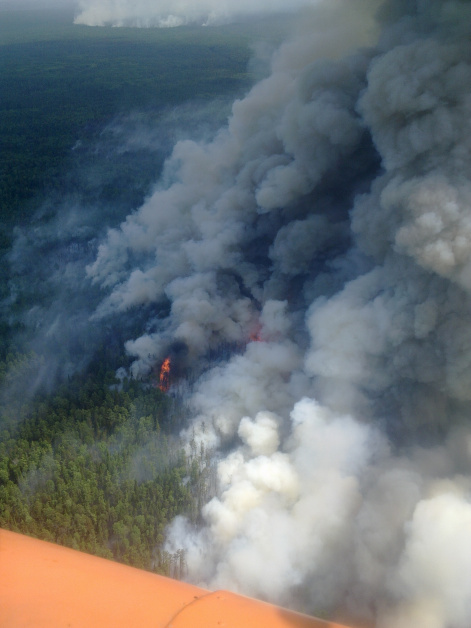Scientists have estimated the impact of arctic fires on carbon emissions
22 November 2021 г.

Arctic boreal ecosystems are among the main carbon sinks. However, an increase in the frequency and intensity of fires threatens this status. Due to northern fires, about 8 million hectares are burned out annually. This is less than 2% of the total area covered by fire in the world, but it accounts for 7% of global annual carbon emissions from fires.
An international team of scientists from the Netherlands, Russia and the United States, which included a researcher of the Krasnoyarsk Science Center of SB RAS, evaluated and made a brief overview of carbon emissions from Arctic fires, and then compared the consequences of fires in the northern ecosystems of the North American and Eurasian continents. These areas have enormous potential for the release of carbon into the atmosphere, both during fires and as a result of long-term "thawing of carbon" from the soil after fire exposure. The increase in the number of arctic-boreal fires could transform these areas from being a long-term sink of atmospheric carbon to its source.
Scientists analyzed data on the Arctic fire areas and the amount of associated carbon emissions over the past twenty years. The researchers then evaluated how the areas covered by fire are distributed between continents, biomes, peatlands, and permafrost zones. The experts note that the overwhelming majority of arctic-boreal fires occur on carbon-rich peatland soils, which have stored carbon in permafrost for many years. As an example, the researchers present an analysis of carbon dioxide emissions after a fire in a forest peat bog in northwestern Canada, where the largest contribution to greenhouse gas emissions was made by carbon accumulated in the permafrost more than a thousand years ago. This carbon was released due to an increase in the depth of the active thawed layer after severe fires and the resulting deeper aeration of the soil and activation of microbial decomposition in it. Most of the carbon stored in arctic-boreal ecosystems is found in carbon-rich peatlands and permafrost. Consequently, fires in these areas can lead to the release of greenhouse gases.
A team of specialists compared the direct carbon emissions from fires in the North American and Eurasian continents. Scientists explain the different behavior of fires in these regions and, accordingly, different amounts of gas emitted by the difference in the dominant tree species on these continents. The flammable black spruce prevails in the northern part of North America. In such forests, during intense fires, there occurs a complete destruction of forest stands. On the contrary, fire-resistant species of larch and pine trees are numerous in Eurasia. Low-intensity ground fires are typical there, and most trees survive there. The main part of carbon emissions, both in Eurasia and North America, is due to the combustion of the ground and peat horizons, which on average account for 50 to 90% of the total fire emissions.
Ground fires in Eurasia produce less carbon emissions than fires killing tree stands in North America. However, recent field studies of organic combustion during high-intensity fires with complete death of trees in forests dominated by larch in Eastern Siberia show that these figures are only slightly lower than those for spruce forests of North America.
“Boreal and Arctic ecosystems currently constitute a carbon sink of the atmosphere. However, fires significantly affect carbon balance and can transform these ecosystems into a carbon source. The fire hazards in the northern regions have increased significantly over the past 100 years, and global and regional patterns indicate a further increase in temperatures and duration of the fire season. It is in the northern regions where the maximum increase in temperature and burning is observed. There is now an urgent need for accurate and unbiased estimates of carbon emissions from fires due to their significant impact on regional and global carbon balance and atmospheric chemistry. For the boreal forests of North America, a large amount of data has already been accumulated on the combustion efficiency and carbon emission during fires in various types of forests, and models of their relationship with meteorological indicators have been developed. For the forests of Russia, such data are scarce. The available estimates of carbon emissions for the territory of Russia are often based on data for ecosystems in North America which are completely different or just on assumptions. Insufficient knowledge of the reserves of combustible materials in forest and tundra ecosystems remains one of the most important sources of errors in assessing fire emissions, ” explained Elena Kukavskaya, Candidate of Biological Science, senior researcher at the V.N. Sukachev Institute of Forest KSC SB RAS.
Scientists note that logging also contributes to the increase in carbon emissions during fires as it leads to a significant increase in the intensity of combustion and, accordingly, to the release of carbon. This is due to an increase in the reserves of combustible materials and their faster drying in felled areas in comparison with forest lands.
This research was supported by the Russian Foundation for Basic Research, Government of the Krasnoyarsk Region and Krasnoyarsk Regional Science Foundation (No. 20-44-242004).
Share:
